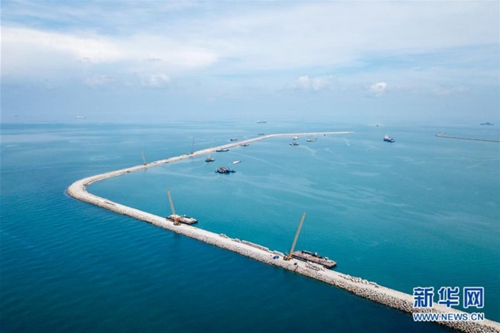Port in Guangxi sees surging cargo throughput due to thriving trade with Southeast Asia
Source:Global Times Published: 2020/6/23 21:19:35

Photo taken on April 28, 2018 shows the construction site of the Kuantan Port New Deep Water Terminal in Malaysia. To coordinate the development of the Malaysia-China Kuantan Industrial Park and improve logistics services, the Guangxi Beibu Gulf Port Group funded the MCKIP and cooperated with the Malaysian government to upgrade Kuantan Port. Photo: Xinhua
The growth in container throughput at Beibu Gulf Port in South China's Guangxi Zhuang Autonomous Region has topped all ports in China in the first five months, thanks to the remarkable trade volume between China and Southeast Asia as the US and the EU have not contained COVID-19.According to statistics from the Ministry of Transport on Monday, the total cargo throughput at Beibu Gulf Port from January to May hit 112.93 million tons, up 15.1 percent year-on-year, and its container throughput grew 33.2 percent year-on-year. Both growth rates ranked first in China.
By comparison, ports in Shenzhen which used to be busy saw only 92.3 million tons of cargo over the same period. The Yantian Port in Shenzhen, South China's Guangdong usually ships goods to Europe, North America and South America.
At a time when most coastal ports are struggling with decreased cargo throughput due to the coronavirus assault, the port in Guangxi has gone against the downward trend and maintained double-digit growth in terms of both its cargo handling capacity and container throughput.
Wu Minghua, a veteran transport industry analyst, gave credit to close contact between ASEAN members and Beibu Gulf Port.
"China's prosperous trade with Southeast Asia is in sharp contrast to the grim shipment industry in Europe and the US, as the latter two have not contained COVID-19," Wu told the Global Times on Tuesday.
He added that during the peak of the COVID-19 pandemic, operations of about 6,000 ships were halted worldwide.
"I have heard that Russian buyers requested to return tea shipped from China and asked for their deposit back from a Chinese trader. Such a situation is in stark contrast to our trade with Southeast Asia," Wu noted.
With a shift in China's foreign trade since the outbreak of COVID-19, Southeast Asia has become the country's largest trading partner. Trade volumes grew 4.2 percent year-on-year to 1.7 trillion yuan ($240 billion) from January to May.
According to the 2019 fiscal report of Beibu Gulf Port Group, among the 46 routes the port runs, 25 are for foreign trade and can reach the main ports in Southeast Asia.
Wu noted that July will be a key month to determine whether or not the global shipping capacity can recover. "May to November is the peak period for global shipping. If Southeast Asia does not see a second wave of the coronavirus, it can maintain the growth momentum through flourishing trade with China and become a highlight of the global shipping industry this year," he said.
Posted in: INDUSTRIES